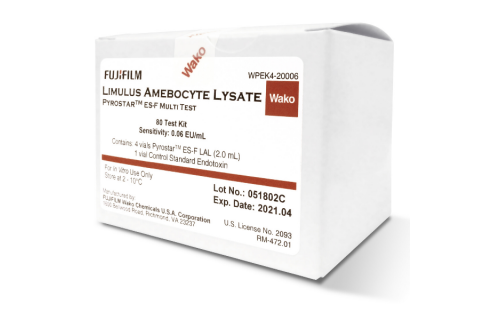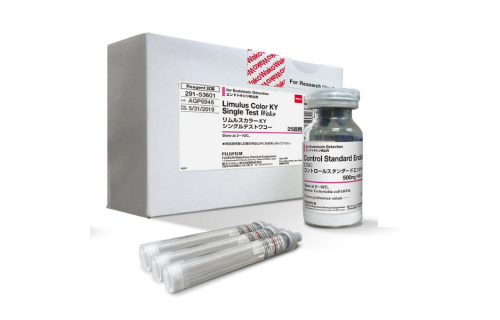Pros and cons of different endotoxin detection readouts
Bacterial endotoxins, when they enter the human bloodstream, can act as powerful pyrogens that lead to fever, inflammation, and in severe cases, septic shock. Gram-negative bacteria, which can be found everywhere in the environment, contain endotoxins in their outer membrane.
The LAL assay, which is the universally accepted test for detecting endotoxins, is approved by regulatory bodies worldwide and included in ‘The International Pharmacopeia’.[1] To comply with the ANSI/AAMI ST108:2023 standard, Critical Water used for reprocessing, sterilization, and rinsing must ensure that the endotoxin level remains below 10 EU/ml. Furthermore, monthly testing is necessary for compliance with this standard.[2]
LAL Assay Endotoxin Detection Methods
LAL Gel-clot Method
The Gel-clot Limulus Amebocyte Lysate (LAL) test received approval from the Food and Drug Administration (FDA) during the 1970s and has since been extensively adopted as the authorized technique for detecting bacterial endotoxins.[3]
The LAL gel-clot method, utilizing PYROSTAR™ ES-F single-test and multi-test kits, represents the most straightforward approach among LAL methods, offering sensitivities ranging from approximately 0.015 to 0.25 EU/mL.
The gel-clot method is considered the most sensitive and precise LAL test, with fewer false positives and reduced vulnerability to interference compared to other methods.
It is; however, a time-consuming process. Moreover, outcomes can be influenced by factors such as pH imbalance, the presence of chemical inhibitors like ethylenediaminetetraacetic acid (EDTA), the viscosity of the substance, denaturing agents like a strong acid or base, a concentrated inorganic salt, or an organic solvent, and basic alcohol compounds.[4]
LAL Kinetic Assays: Chromogenic Method and Turbidimetric Method
Kinetic assays can be conducted using both chromogenic and turbidimetric methods, wherein the development of color or turbidity is measured throughout the incubation time. These assays are quantitative in nature.
The techniques are acknowledged in the pharmacopoeias of various countries, such as Europe, the United States, Japan, and China, for the identification of endotoxin activity in water and pharmaceutical products.[5]
Chromogenic Assay
FUJIFILM Wako’s Limulus Color KY series includes the Limulus Color KY single-test kit for use on the Toxinometer® measurement system and the Limulus Color KY Multi-test kit which can be utilized on either the Toxinometer® or a microplate reader.
These quantitative, kinetic, chromogenic assays have an extremely high sensitivity with a quantitative range detection limit of 0.0002 EU/mL for the single-test format and 0.0005 EU/mL for the multiple-test format. They also include endotoxin-specific reagents and enable the ability to perform high-throughput LAL testing when utilizing the microplate platform.
The automated LAL chromogenic method saves time, allows for more tests to be completed and is known for its user-friendly nature and simple calculation process. [4]
Nevertheless, outcomes might differ due to the significant differences in the coefficient of variation (CV), which assesses the precision of testing. Test sensitivity indicates that interference can pose problems. Such interference may arise from substances that denature proteins, bind endotoxin, or lead to precipitation.
Occasionally, samples such as serine proteases could change color upon reaction with the LAL, which might interfere with the test findings. [4]
Turbidimetric Assay
The turbidimetric method measures either the time required for the reaction mixture to reach a predetermined absorbance or transmission level or the rate of turbidity development.[6]. It's an automated extension of the gel-clot test. The modified LAL reagent has reduced coagulogen, leading to a turbid mixture that does not clot when exposed to endotoxin.
FUJIFILM Wako offers three KTA kits: PYROSTAR™ ES-F single-test for the Toxinometer®, PYROSTAR™ ES-F multi-test for the Toxinometer®, and PYROSTAR™ ES-F/Plate for the Microplate Reader, all of which are endotoxin specific.
The PYROSTAR™ ES-F single-test and multi-test kits, used on the Toxinometer® measurement system, have enhanced sensitivity with a range of 0.001–10 EU/mL. The PYROSTAR™ ES-F/Plate kit, which enables engagement in high-throughput LAL testing, has a quantitative range of 0.01–10 EU / mL.
By utilizing the turbidimetric method instead of the simpler gel-clot method, one can obtain a quantitative result, revealing the precise level of endotoxin in the sample solution.
However, the turbidimetric method's effectiveness in testing blood, plasma, serum, and similar materials can be compromised due to its heightened vulnerability to false positives caused by interference from suspended or turbid products. [4]
Summary
It is crucial to evaluate the suitability of each LAL Assay Endotoxin Detection Method, as each method has its own strengths and weaknesses. Technicians who have been trained in these methods can minimize the impact of interference and prevent false results.
Despite the drawbacks linked to these approaches, they have gained global acceptance and play a vital role in safeguarding patient well-being.
References
- Mehmood, Y., What Is Limulus Amebocyte Lysate (LAL) and Its Applicability in Endotoxin Quantification of Pharma Products. 2019.
- Vockley, M.J.J.o.C.E., AAMI Publishes First National Standard on Water Quality for Medical Device Processing. 2024. 49(1): p. 30-31.
- Meisel, J., Determination of Pyrogens: Comparison of Different Methods. Altex, 1995. 12(2): p. 89-92.
- Wheeler, A., Comparing Endotoxin Detection Methods. Pharmaceutical Technology, 2017. 41(11): p. 58-62.
- Flórez, P., et al., Intralaboratory Validation of a Kinetic Turbidimetric Assay Based on Limulus Amebocyte Lysate (LAL) for Assessing Endotoxin Activity in Cow Milk. Animals (Basel), 2023. 13(3).
- Healthcare, E.D.f.t.Q.o.M.a., European Pharmacopoeia. 2016: Strasbourg, Council of Europe.






